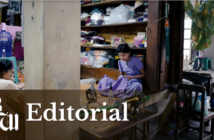Nepal’s Dharahara Tower, located within the country’s capital city of Kathmandu, once stood proudly at nine stories high. Its rounded, pure white walls wrapped a thin cylinder around its internal spiral staircase, to which tourists flocked to climb for “birds-eye views of the ancient city.”
But only a small chunk of the watchtower now remains.
Originally constructed in 1832 and reconstructed in 1934 after an earthquake devastated the city, the Dharahara Tower was once again demolished by a 7.8-magnitude quake April 25. Among the other architectural casualties of the natural disaster were several temples in the city’s Basantapur Durbar Square, Patan Durbar Square, the monastery and shrines at the Nepalese heritage site of Swayambhunath, as well as thousands of homes and other buildings, ABC News reported.
But that is to say nothing of the earthquake’s human cost.
As CNN reported, more than 5,200 people were confirmed dead, and another 10,348 were injured during the quake and its aftermath. The network said Nepal’s neighboring countries, India and China, also reported death tolls of 72 and 25, respectively. Furthermore, an earthquake-triggered avalanche on Mount Everest, located in eastern Nepal, resulted in the deaths of at least 18 climbers at the mountain’s base camp, The New York Times reported. And still other areas of the country have been ransacked by landslides since April 25.
The United Nations estimated that, in total, some 8 million people have been directly affected by the quake and that 1.4 million are in need of food-related assistance. More than 100,000 had reportedly evacuated Kathmandu as of April 29, and officials estimate that 200,000 more could follow — effectively draining the capital of 10 percent of its population, according to The Guardian.
In short, Nepal is on a long road to recovery, and we should do our best to help its people.
Of course, our society is not without its own significant and pressing problems. But unlike many other forms of crisis, natural disasters are beyond direct human control. They therefore pose a threat to the wealthiest, poorest, weakest, strongest, and most or least powerful among us — and everyone in between — without existing as the result of some social construction.
None of us have the capabilities to totally isolate or protect ourselves from such disasters. Simply, they present forces that are far more powerful than any tangible resource — and therefore unite us in our vulnerability when confronted with them. We may not experience the same crises, but we remain linked by this bond.
And providing financial support for those affected — not just by natural occurrences, but any problem — is not enough. Yes, finances help kick-start our path to eradicating many issues. But when we merely swipe our credit cards, we may not fully comprehend the extent of the situation we’re trying to alleviate. When we become directly involved in causes, however, we feel their impact and are able to connect with those affected on a far more empathetic and personal level.
This is not to suggest that we should all abandon our classes, jobs and lives to jet off in the hopes of saving the global population — and by all means, if you believe in a cause, contribute to it in whatever way possible. But we must also make an effort to get hands-on experience with helping others when we can — even locally.
Media certainly help dictate where our attention goes, and naturally, publications rapidly change their focuses to cater to audiences’ evolving interests. Media are powerful, but the images, videos and stories we see or read still place us behind a protective screen or piece of paper. While they are vehicles for information, they cannot always provide the full, in-person picture of any circumstance.
So, go out and get involved with bettering our world in whatever way possible — whether through an official service organization, through a simple kind gesture to another, or otherwise. Understand that pain and suffering may be elements of the human condition. But so is having the compassion to help others through it.





Comment policy
Comments posted to The Brown and White website are reviewed by a moderator before being approved. Incendiary speech or harassing language, including comments targeted at individuals, may be deemed unacceptable and not published. Spam and other soliciting will also be declined.
The Brown and White also reserves the right to not publish entirely anonymous comments.